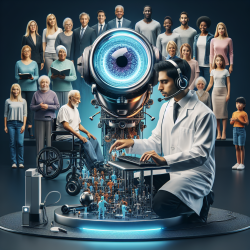Understanding Research Human Capital Density
In the realm of speech-language pathology, data-driven decision-making is crucial for enhancing therapeutic outcomes. A recent study by Ayan, Haak, and Ginther (2023) sheds light on the concept of Research Human Capital Density (RHCD) as a potent metric for evaluating and fostering innovation capacity. This concept has significant implications for practitioners in the field, particularly those engaged in online therapy services like TinyEYE.
Key Findings of the Research
The study posits that RHCD, which measures the concentration of individuals engaged in research and development (R&D) activities, provides more explanatory power than traditional metrics like Gross Domestic R&D expenditures (GERD) when it comes to predicting research outputs such as patents and publications. This finding suggests that the human element in R&D is a critical driver of innovation.
For speech-language pathologists, this insight underscores the importance of investing in human capital—specifically, in the skills and knowledge of practitioners. By fostering a culture of continuous learning and development, practitioners can enhance their ability to innovate and improve therapeutic outcomes.
Implementing RHCD in Speech-Language Pathology
Practitioners can leverage the concept of RHCD by:
- Engaging in Continuous Professional Development: Regularly updating skills and knowledge through workshops, seminars, and courses can increase a practitioner's research capacity and innovation potential.
- Collaborating with Researchers: Building partnerships with academic institutions and researchers can provide access to cutting-edge research and methodologies that can be applied in therapeutic settings.
- Participating in Research Activities: Involvement in research projects can enhance understanding of emerging trends and technologies, allowing practitioners to integrate these insights into their practice.
Encouraging Further Research
While the study provides a robust framework for understanding the role of human capital in R&D, it also highlights the need for further research in this area. Practitioners are encouraged to contribute to this body of knowledge by conducting their own research and sharing findings with the broader community.
Such efforts can help refine the RHCD metric and its application in various fields, including speech-language pathology. By doing so, practitioners can play a pivotal role in advancing the field and improving outcomes for children receiving therapy services.
Conclusion
The concept of Research Human Capital Density offers a valuable lens through which to view innovation in speech-language pathology. By focusing on the development of human capital, practitioners can enhance their capacity for innovation and improve therapeutic outcomes. For those interested in delving deeper into this topic, the original research paper provides a comprehensive analysis of RHCD and its implications.
To read the original research paper, please follow this link: How many people in the world do research and development?










